Lessons Learned – by Pat Carson

Ensigns, Jacks And Flags
A half dozen years back I wrote about flag etiquette on vessels and this month I wanted to again review how to properly fly our flags, ensigns and burgees on our boats. There are several rules, regulations and etiquette attached to hoisting flags on vessels. Apart from the national flag for which the ship belongs to, there are various other types of flags that are used for signaling and navigational purposes. Large vessels display flags for mainly three reasons – to display the nationality of the ship, to display the status assigned to them because of the services they offer and to provide courtesy in accordance with the international rules and regulations. Whether you are sailing a ship, a ferry or a yacht, flag etiquette at sea remains the same for all.

Ensign
The main flag flown on all vessels is the ensign; it is the most important flag on board and identifies the ship’s national identity. A vessel’s character is determined by her registration, which may be different from that of her owner as it is not uncommon to see yachts that are registered in countries of convenience. The term flag of convenience describes the business practice of registering a merchant ship in a state other than that of the ship’s owners and flying that state’s civil ensign on the ship. Any vessel may be registered under flags of convenience to reduce operating costs, to avoid the regulations of or avoid inspection and scrutiny by the owner’s country. Normally the nationality of the ship determines the taxing jurisdiction. The common practice of ships being registered in a foreign country began in the 1920s in the United States when ship owners seeking to serve alcohol to passengers during Prohibition registered their ships in Panama. Owners soon began to perceive advantages in terms of avoiding increased regulations and rising labor costs and continued to register their ships in Panama even after Prohibition ended. The use of open registries steadily increased, and in 1968 Liberia grew to surpass the United Kingdom as the world’s largest ship registrar. Currently, more than half of the world’s merchant ships are registered with open registries, and almost 40% of the entire world fleet, in terms of deadweight tonnage, are registered in Panama, Liberia and the Marshall Islands.
The flag state of a merchant vessel is the jurisdiction under whose laws the vessel is registered or licensed and is deemed the nationality of the vessel. A merchant vessel must be registered and can only be registered in one jurisdiction, but may change the location in which it is registered. The flag state has the authority and responsibility to enforce regulations over vessels registered under its flag, including those relating to inspection, certification and issuance of safety and pollution prevention documents. As a ship operates under the laws of its flag state, these laws are applicable if the ship is involved in an admiralty case. See my June 2019 Bay & Delta Yachtsman article regarding the Jones Act and how foreign registered vessels are limited in U.S. coastwise cabotage.

Flying the proper ensign is especially important when outside of the United States and on the high seas. This flag has the color of the vessel’s nationality and according to United States rules should be raised before any other flag at sunrise and lowered last at sunset, whether the ship is at port or at sea. It is also important to take the flag down prior to leaving the yacht if the ship will be unmanned at the time of sunset. There are also rules that govern the position and height of the ensign and all other flags. The landlubbers’ rule that the highest flown flag takes precedence does not apply on board a ship: The position of honor on a ship is the quarterdeck at the stern of the ship, and thus ensigns are traditionally flown either from an ensign staff at the ship’s stern, or from a gaff rigged over the stern. A motoryacht without a mast should fly the ensign at the stern of the vessel as this is always in a superior position to a flag flown elsewhere on the ship, even if the latter is higher up.
When deciding which of the two United States ensigns to fly, you have the choice of either the yacht ensign with its fouled anchor over a circle of 13 stars also referred to as the Betsy Ross flag, or the 50-star Old Glory flag that we are all very familiar with. The Betsy Ross ensign was established by Congress in 1848 to identify yachts that did not have to clear customs when entering ports, however the law has changed so that the yacht ensign is now an option for any American recreational vessel. Thus, either the national ensign or yacht ensign may be flown by U.S. yachts, but not simultaneously. However, U.S. flagged vessels must fly the 50-star ensign when sailing in international waters.
Flags come in standardized sizes, but there are guidelines about selecting the proper size. The dimensions of your yacht ensign are determined by the size of the vessel that flies it. The flag at the stern of your boat, the United States ensign or other national flag, should be the largest flag on the vessel with the fly being one inch per foot of overall boat length and with the hoist being two-thirds of the fly. For example, on a 60-foot boat, the ensign should be 60 inches in fly and 40 inches in hoist. Flags are more often too small rather than too large, so round upward to the larger standard size.

The flying of two ensigns of two countries, one above the other, on the same staff is a sign that the vessel concerned has been captured or has surrendered during wartime. The ensign flying in the inferior, or lower, position is that of the country the ship has been captured from: conversely, the ensign flying in the superior, or upper position, is that of the country that has captured the ship.
As a courtesy, should a merchant or private ship pass by a warship, the merchant ship must lower her ensign as a matter of respect to the warship, the warship will then lower her ensign as an acknowledgement to the respect given. Contrary to popular belief, the United States Navy does dip the Stars and Stripes in acknowledgement of salutes rendered to it.
Jacks
The blue-fielded white-starred flag is the Jack of the United States. It represents U.S. nationality and is flown from the jackstaff at the bow of all navy ships that are moored or anchored from 0800 to sunset. On Oct. 13, 1975, all commissioned U.S. Navy warships switched to the First Navy Jack in commemoration of the bicentennial of the United States Navy and the U.S. founding’s bicentennial. It was used in this capacity until Dec. 31, 1976 when the 50-star jack was re-adopted.

The Jack of the United States returned as the U.S. Navy’s official jack on June 4, 2019, however the USS Constitution, the oldest ship in the navy, still flies the First Navy Jack. From Aug. 18, 1980 onward, the active commissioned ship having the longest total active period uses the First Navy Jack instead. Currently, that ship is USS Blue Ridge (LCC-19). The 50-star jack was ordered to be re-adopted by commissioned U.S. Navy warships on Feb. 21, 2019, effective June 4, 2019, to coincide with the anniversary of the Battle of Midway. Today all U.S. Navy warships, U.S. Coast Guard ships, civilian manned replenishment ships that support the military, Military Sealift Command (MSC) and ships of the National Oceanic and Atmospheric Administration (NOAA) fly the Union Jack and it is required to be of the same size as the ensign being flown from the stern of the ship.

Courtesy flags are also flown from the jackstaff at the bow. This seems to some landlubbers as being a reversal of priorities, however as yachtsmen we know that a boat is steered by the stern and this gives the ensign pride of place. When the ship leaves port, the flag of the destination country is hoisted at the jackstaff or foremast of the ship, along with any desired signal flag hoisted at the starboard.
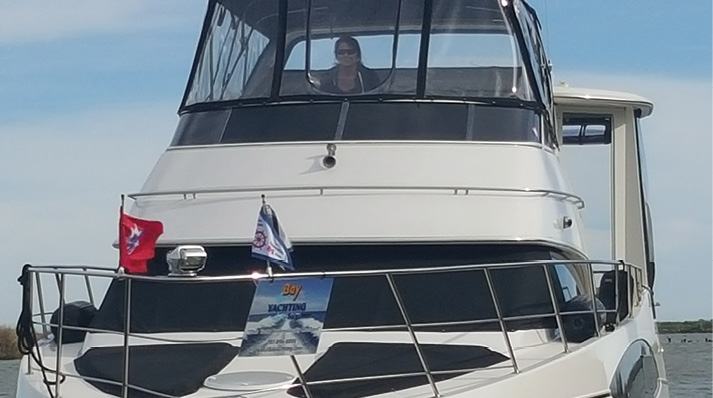
Jacks that are flags smaller than ensigns are used for signaling and distinction. For example, if a pilot is on board, the alphabetical flag “H” is hoisted. In case the maneuvering of the ship continues even after sunset and the pilot is still on board, all flags except the pilot flag are hauled down. When the pilot disembarks the “H” flag is then hauled down. When the ship reaches the destination country, the ensign flag of that country is flown from the yardarm of the ship. This flag is also termed as the courtesy flag of this country and is always flown above all the other flags. Thinking this does not matter, we should show our neighbors to the north and south this courtesy as we are visiting their country.
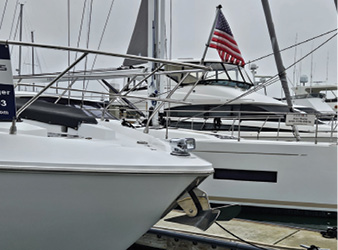
Flags such as club burgees, private signals and courtesy flags used on sailboats should be approximately .5-inch fly for each foot of the highest mast above the water. For example, on a 30-foot sailboat with 50 feet between the masthead and the water the burgee should be about 25 inches. The shape and proportions of pennants and burgees will be prescribed by the organization which they relate to.
Signal Flags
Signaling flags have different colors and shapes much like the written alphabet. There are 26 alphabetical flags, 10 numeric flags, one answering flag and three substitute flags. Usually, two to three flags are used in combination along with pennants for sending a message. Alphabetical flags are also used individually to indicate to a passing ship of a particular condition. For example, the Alpha flag is used to signal that I have men in the water, the Bravo flag is used to signal I am taking in, discharging or carrying dangerous cargo.



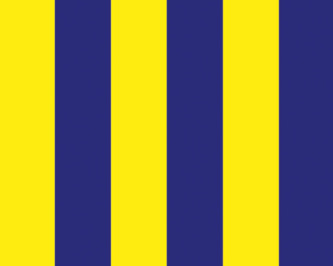

A few notes on the Alpha flag vs. the traditional sport diver’s flag. The distinction that the Coast Guard makes is that the Alpha flag is a navigational signal intended to protect the vessel from collision. The sport diver flag is an unofficial signal that, through custom, has come to be used to indicate a diver in the water. To be most effective, the sport diver’s flag should be exhibited on a “float” in the water to mark the diver’s approximate location and the Alpha flag is flown from the support vessel. The two flags, therefore, are not mutually exclusive, but may be flown together whenever their respective conditions both apply. The position of the Coast Guard is when in doubt, exhibit both flags. Neither is to be exhibited when underway to or from the scene of diving, or when divers are not actually in the water.
Some of the common signal flags that you will see in the San Francisco Bay Area are the Golf flag and the Hotel flag. When arriving at a port and before reaching the pilot area, the ensign flag of that country is hoisted at the stern of the ship. The ensign of the country from where the ship came is hoisted at the bow of the ship. The Golf flag which signals the need of a pilot, is also hoisted. When the ship leaves the pilot station and before it reaches the quarantine station, the quarantine signal flag Quebec is hoisted. After leaving the quarantine station the Quebec flag is removed before the ship reaches the berth and the Hotel flag indicating that the pilot is on board is flown.
Flag Retirement
When a flag is so worn it is no longer fit to serve as a symbol of our country, it should be destroyed by burning. The United States Federal Law, 36 USC 176(k), provides that the flag, when it is in such condition that it is no longer a fitting emblem for display, should be destroyed in a dignified way, preferably by burning.
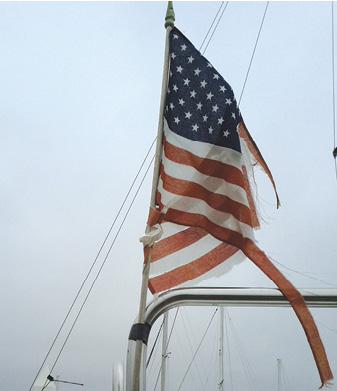
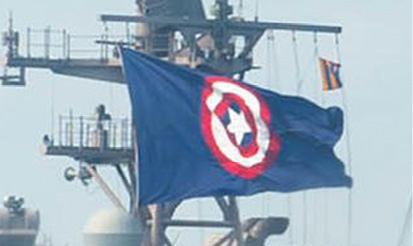
When your flag is worn beyond repair, cut it into small pieces that will burn easily and completely on a modest, but blazing fire so that it is reduced to ashes and unrecognizable as a former flag. This should be done in a simple manner with dignity and respect. Remember, as you look at your flag, which is the symbol of our nation, that it is red because of human sacrifice, it is blue because of the true-blue loyalty of its defenders and it is white to symbolize liberty – our land of the free. The stars are symbols of the united efforts and hope in the hearts of many people striving for a greater, nobler America.
Time for me to sit back, enjoy a good glass of port and light up a fine cigar while I plan for a summer of boating fun.
Until next month please keep those letters coming. If you have a good story to tell, send me an email at patcarson@yachtsmanmagazine.com. I love a good story. Have something to share that is right or wrong, please email your high-resolution photos.



